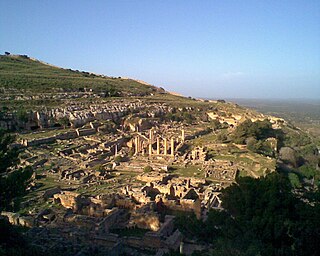
Cyrene or Kyrene was an ancient Greek and later Roman city near present-day Shahhat, Libya. It was the most important of the five Greek cities in the region, known as the pentapolis. It gave eastern Libya the classical name Cyrenaica, which it has retained to modern times.
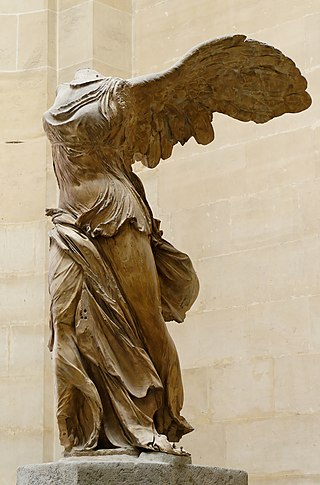
Parian marble is a fine-grained semi translucent pure-white and entirely flawless marble quarried during the classical era on the Greek island of Paros in the Aegean Sea.

The sculpture of ancient Greece is the main surviving type of fine ancient Greek art as, with the exception of painted ancient Greek pottery, almost no ancient Greek painting survives. Modern scholarship identifies three major stages in monumental sculpture in bronze and stone: the Archaic, Classical (480–323) and Hellenistic. At all periods there were great numbers of Greek terracotta figurines and small sculptures in metal and other materials.
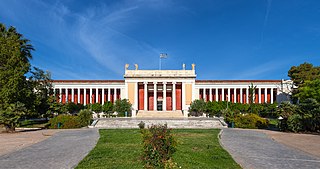
The National Archaeological Museum in Athens houses some of the most important artifacts from a variety of archaeological locations around Greece from prehistory to late antiquity. It is considered one of the greatest museums in the world and contains the richest collection of Greek Antiquity artifacts worldwide. It is situated in the Exarcheia area in central Athens between Epirus Street, Bouboulinas Street and Tositsas Street while its entrance is on the Patission Street adjacent to the historical building of the Athens Polytechnic university.

Apollonia in Cyrenaica was founded by Greek colonists and became a significant commercial centre in the southern Mediterranean. It served as the harbour of Cyrene, 20 km (12 mi) to the southwest.

The Capitoline Venus is a type of statue of Venus, specifically one of several Venus Pudica types, of which several examples exist. The type ultimately derives from the Aphrodite of Cnidus. The Capitoline Venus and her variants are recognisable from the position of the arms—standing after a bath, Venus begins to cover her breasts with her right hand, and her groin with her left hand.
Marion True was the former curator of antiquities for the J. Paul Getty Museum in Los Angeles, California. True was indicted on April 1, 2005, by an Italian court, on criminal charges accusing her of participating in a conspiracy that laundered stolen artifacts through private collections and creating a fake paper trail; the Greeks later followed suit. The trial brought to light many questions about museum administration, repatriation, and ethics.

The Getty kouros is an over-life-sized statue in the form of a late archaic Greek kouros. The dolomitic marble sculpture was bought by the J. Paul Getty Museum, Los Angeles, California, in 1985 for ten million dollars and first exhibited there in October 1986.
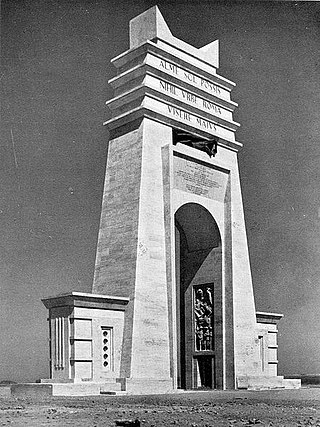
The Marble Arch, also Arch of the Philaeni, formerly known in Libya as El Gaus, was a monument in Libya built during the days of Italian colonization. The arch marked the border between Tripolitania and Cyrenaica, and was located on the Via Balbia near Ra's Lanuf.
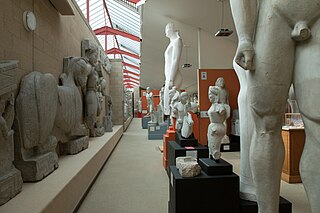
The Museum of Classical Archaeology is a museum in Cambridge, England, housed in the Faculty of Classics of the University of Cambridge. Since 1983, it has been located in a purpose-built gallery on the first floor of the Faculty of Classics on the Sidgwick Site of the university.
The Extramural Sanctuary of Demeter and Persephone at Cyrene, Libya is located on a coastal plateau of Libya, beyond the boundaries of the city (extramural). In approximately 630 BC Greeks from the island of Thera colonized Cyrene. Other Greek colonists not long after increased the population, thus transforming Cyrene into what was regarded as both the largest and wealthiest Greek colony of North Africa. Archaeological excavations of Cyrene's Extramural Sanctuary of Demeter and Persephone, also known as Kore, daughter of Demeter and legendary Queen of the Underworld and consort of Hades, began in 1969 under the sponsorship of the University of Michigan. Between 1973 and 1981 the University of Pennsylvania Museum of Archeology and Anthropology continued the excavations at Cyrene under the direction of Professor Donald White. Following the renewal of relations between Libya and the United States in 2004, the Cyrenaica Archaeological Project (CAP), under the direction of Professor Susan Kane of Oberlin College, was granted permission to resume the work of its predecessors.
Apollonia Museum is an archaeological museum located in Susa, Libya. Its collection includes ancient Libyan and Ptolemaic sculptures, funerary art, architectural elements, ceramics, and other household items. The museum houses a lot of history that includes Greek and Latin artifacts.

Gods in Color or Gods in Colour (original title in German: Bunte Götter – Die Farbigkeit antiker Skulptur is a travelling exhibition of varying format and extent that has been shown in multiple cities worldwide. Its subject is ancient polychromy, i.e. the original, brightly painted, appearance of ancient sculpture and architecture.

Major General Sir Robert Murdoch Smith KCMG FRSE was a Scottish engineer, archaeologist and diplomat. He is known for his involvement with the excavation of antiquities found at Knidos and Cyrene, the telegraph to Iran, Persian antiquities bought for the Victoria and Albert Museum, and for serving as Director of the Edinburgh Museum of Science and Art.

The Phrasikleia Kore is an Archaic Greek funerary statue by the artist Aristion of Paros, created between 550 and 540 BCE. It was found carefully buried in the ancient city of Myrrhinous in Attica and excavated in 1972. The exceptional preservation of the statue and the intact nature of the polychromy elements makes the Phrasikleia Kore one of the most important works of Archaic art.
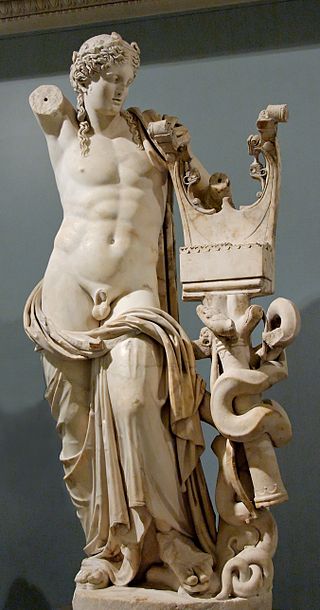
The Apollo of Cyrene is a colossal Roman statue of Apollo found at the ancient city of Cyrene, Libya. It was unearthed at the site along with a large number of other ancient sculptures and inscriptions which were presented to the British Museum in 1861.
The Peplos Kore is an ancient sculpture from the Acropolis of Athens. It is considered one of the most well-known examples of Archaic Greek art. Kore is a type of archaic Greek statue that portray a young woman with a stiff posture looking straight forward. Although this statue is one of the most famous examples of a kore, it is actually not considered a typical one. The statue is not completely straight, her face is leaned slightly to the side, and she is standing with her weight shifted to one leg. The other part of the statues name, peplos, is based on the popular archaic Greek gown for women. When the statue was found it was initially thought that she was wearing a peplos, although it is now known that she is not.

The Kore of Lyons is a Greek statue of Pentelic marble depicting a bust of a young girl of the kore type, conserved at the musée des beaux-arts de Lyon, France. Deriving from the Athenian Acropolis, it is generally dated to the 540s BC. Considered the centrepiece of the museum's antiquities department, the statue was acquired between 1808 and 1810.
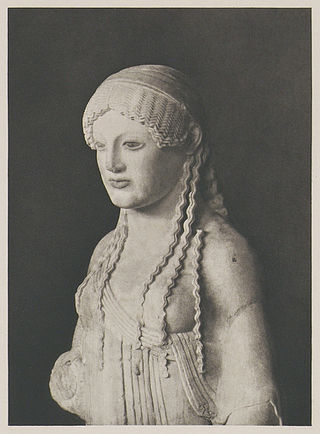
The Euthydikos Kore is a late archaic, Parian marble statue of the kore type, c 490–480 BCE, that once stood amongst the Akropolis votive sculptures. It was destroyed during the Persian invasion of 480 BCE and found in the Perserschutt. It is named after the dedication on the base of the sculpture, “Euthydikos son of Thaliarchos dedicated [me]”. It now stands in the Acropolis Museum.
The Temple of Zeus was the largest ancient Greek temple at Cyrene, Libya, and one of the largest Greek temples ever built. The original Doric octastyle peripteral temple was constructed around 500-480 BC, and heavily damaged in 115 AD. Later in the century, it was partially rebuilt as a non-peripteral temple with a colossal cult statue. It was destroyed once more in 365 AD by an earthquake and then burnt by Christians.

















